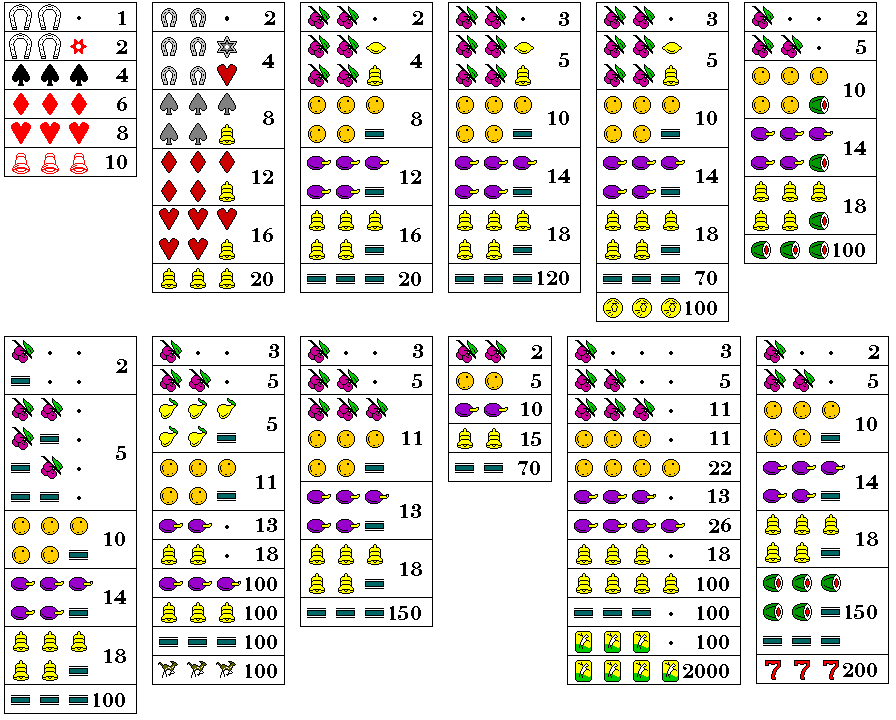
The following image illustrates some of the ways that slot machines have changed over the years.

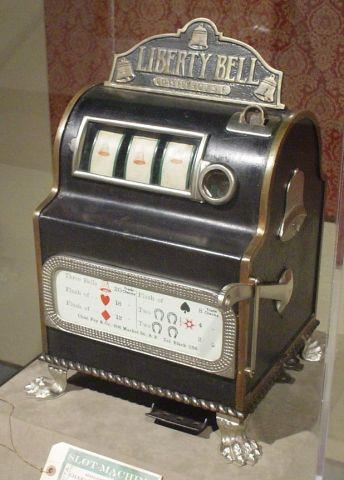 |
The image above is from Wikimedia Commons, licensed under the GNU Free Documentation License, and is thus available for your use under the same terms. Its author is Nazox; the image here is resized and cropped from the original. |
In the top row, the first set of payouts shown are those of the first slot machine (but not with the first set of reel strips used with it), as invented by Charles Fey. A photograph of the specimen of this machine which was on display at the Liberty Belle Saloon in Reno, Nevada (this business, owned by Charles Fey's grandsons Marshall Fey and Frank Fey, closed down in 2006) is shown at right.
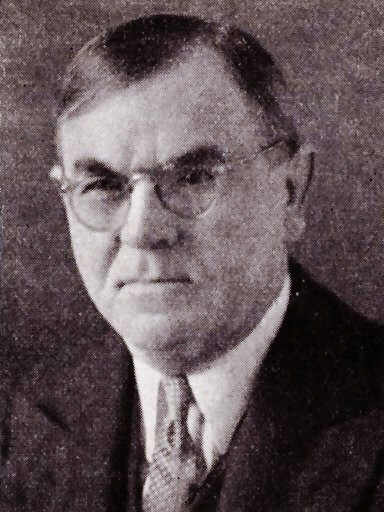
Charles Fey was born on September 9th, 1862, as August Joseph Fey. He changed his name to Charles, as he didn't like being called "Gus", but his full name is usually given as Charles August Fey - rather than Charles Joseph Fey, as one might expect if August was changed to Charles - and that is also how he signed at least one photograph, apparently.
He came to the United States at age 23, having been born in Bavaria before the unification of Germany.
He had a cordial relationship with several of the other participants in the slot machine industry, including Herbert Mills and Thomas Watling.
Recently, a cigarette lighter was made with a design that resembled Charles Fey's original Liberty Bell slot machine. I'm not aware of any other toy or replica slot machine made to look like it. Some years back, there was a line of pencil sharpeners made to resemble various objects, one of which being a slot machine. One version of the slot machine looked like a Watling Rol-a-Top (the Die-cast 9619, or Play-Me 980), but the other one (the Die-Cast 9615, so they were indeed by the same company), although it looked like an early slot machine, didn't resemble any real slot machine I knew of. Recently, I unravelled that mystery; it was made to look like the "Roaring Twenties Silver Eagle Slot Machine", a 1977 toy by Poynter. The small bronze pencil sharpener bore the words "Golden Eagle" below the eagle on the case.
Some recent web searches suggest that there may be a connection between Die-Cast and Play-Me on the one hand and Poynter Products, possibly most famous for the "Mighty Tiny" miniature toy record player, on the other, although I did not turn up anything conclusive.
The most commonly quoted date for the invention of the three-reel slot machine with automatic payout by Charles Fey is 1895, as given by John Scarne; however, the 1995 book Lemons, Cherries, and Bell-Fruit Gum by Richard Bueschel, a carefully-researched history of the slot machine, sets the date at 1905 instead, giving Charles Fey only a year, instead of a decade, to profit from his invention before the San Francisco Earthquake of 1906. On the other hand, Slot Machines: A History of the First 100 Years by Charles Fey's grandson Marshall Fey gives an earlier date, although still later than Scarne's, of 1898 for its invention. The first of these machines had reel strips with pictures of playing cards on them instead of just suit symbols; however, changing the reel strips and payout cards on a slot machine to use a different style of symbol is sufficiently trivial that it is not unreasonable to view the original version and the more common one as the same machine.
The contents of the reels are:
(*) Star - - 2 (%) Horseshoe 5 5 - (O) Spade 2 2 2 (@) Diamond 1 1 3 (A) Heart 1 1 1 (=) Bell 1 1 2
Given its payouts,
%%. 1 %%* 2 OOO 4 @@@ 6 AAA 8 === 10
one can calculate how much it returns on 1000 coins:
5 * 5 * 8 = 200 * 1 = 200
5 * 5 * 2 = 50 * 2 = 100
2 * 2 * 2 = 8 * 4 = 32
1 * 1 * 3 = 3 * 6 = 18
1 * 1 * 1 = 1 * 8 = 8
1 * 1 * 2 = 2 * 10 = 20
---
378
A return of 37.8% gives a profit of 62.2%, which is quite high.
However, Marshall Fey's book, Slot Machines: The First 100 Years, gives its payout as double that, which is more reasonable. The payout card gave the payout as a number of drinks; apparently, if the machine took nickels, a drink cost ten cents, so each drink was actually equivalent to two coins.
Note that these symbols, although different from those used on later machines, can be seen as corresponding to them: horseshoes become cherries, the star becomes the lemon, spades become oranges, the diamond becomes the plum, hearts become bells, and the bell becomes the bar.
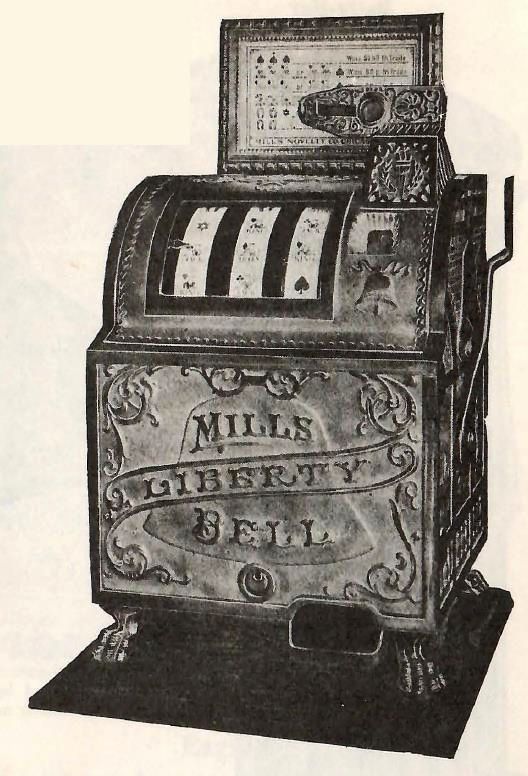
This is made more obvious by the second set of payouts, in which all the prizes are (or, rather, appear to be, given that a drink is worth two coins, as noted above) doubled, and the feature of allowing a bell on the last reel to complete most three-in-a-row combinations is added. These are the payouts of the first slot machine made by Mills, the Mills Liberty Bell slot machine. A version of that machine, but with playing card symbols on the reels, is shown at right.

The third set of payouts shown is that of the Mills Novelty Company's Operator's Bell slot machine, pictured at left, which introduced the conventional fruit symbols which are now so strongly associated with slot machines, as they became popular and were quickly copied by the other companies that began to copy Charles Fey's invention. Except for the symbols used being changed, that set of payouts is the same as that offered on their earlier Liberty Bell, which used the same symbols as the original machine by Charles Fey.
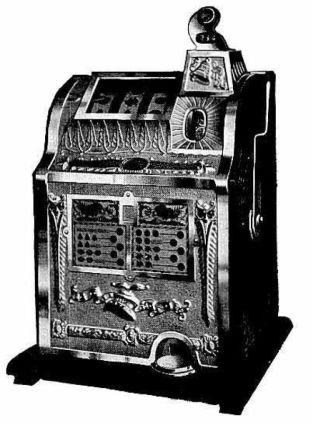
Another early Mills slot machine but still one of the early models, modified so that it wasn't raised above the counter by feet on the bottom, so as to make room for a larger coin box is pictured at right. Although these machines was quite different in appearance from Charles Fey's original machine, for a while not only later Mills machines, but other early machines from Caille, Watling, Jennings and Pace (and others, such as Cooper Manufacturing and Silver King) were much the same as this machine and the first Mills three-reel slot machine from 1907 in general appearance.
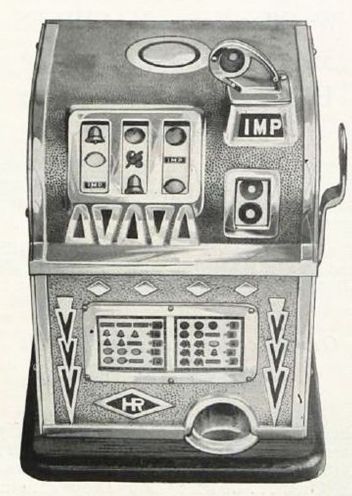
In 1931, Benton Harbor Novelty brought out their Imp slot machine, pictured at left, not to be confused with the Imp trade stimulator by Groetchen from 1940 (although one source shows the same device as made by Engel Manufacturing in 1927). This slot machine had the same shape as the early slot machines, but was of a somewhat smaller size, being about 16 and a half inches tall.
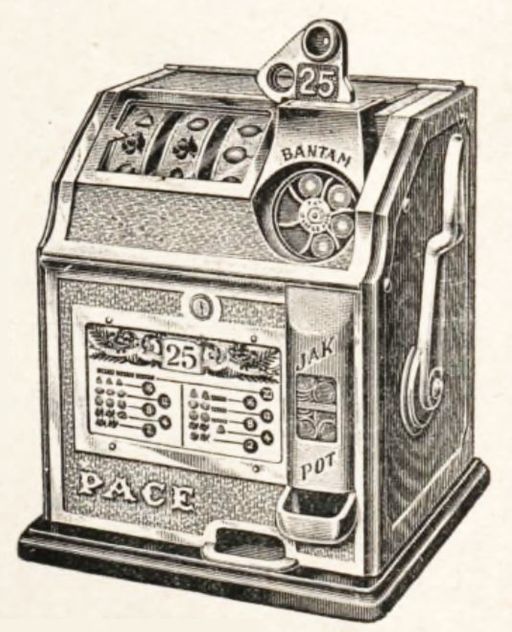
The Pace Bantam, another smaller machine with a standard shape, was not quite as small, at 19 and a half inches in height, is shown at right. It is sometimes referred to as being "three-quarter size"; a full-sized slot machine of the kind to which it might be compared could be 25 inches tall. Thus, these machines serve as testimony to the enduring popularity of what came to be seen as the basic slot machine shape.
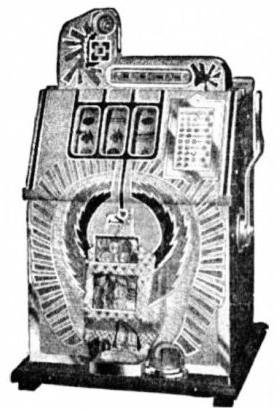
1931 was also the year when Mills brought out the Mills Silent slot machine, which decisively ended the dominance of this style and shape for slot machines. The Mills War Eagle, one of the initial styles in which the Mills Silent was introduced, is illustrated at left.
The two other initial styles of the Mills Silent are illustrated below: the Mills Front O.K. Vendor, for territories where it was necessary to incorporate a vending attachment with the slot machine, and the "Lion Front" which retained the older style of case, but with the newer silent mechanism.

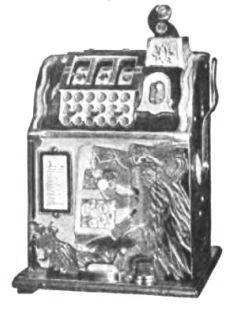
The Caille Superior arrived earlier, dating back to at least 1926, and as well, by 1929, Watling slot machines were already being made in the "Blue Seal" style, but the Mills Silent was a more radical departure from earlier slot machines in styling. Two styles of the Caille Superior and the Watling Blue Seal, respectively, from left to right, are pictured below:
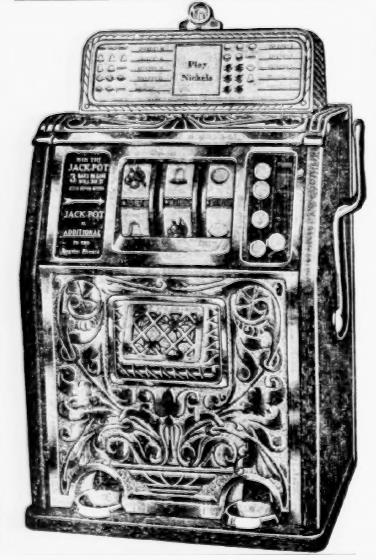

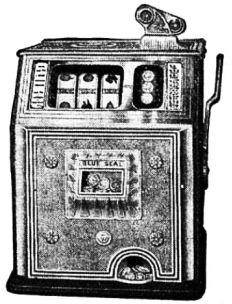
A gum vending version of Mills' earlier Liberty Bell machine which was introduced in 1910, the same year that the Operator's Bell came out, also used the modern fruit symbols, except that while the letters of the word "GUM" appeared over the symbols in most cases, in the case of the plum, the letters were made out of many tiny plums, in the case of the lemon, three lemons on a branch were intertwined with the letter - and the cherries were replaced by a leaf, representing the spearmint flavor of gum.
Instead of a black, or dark green, bar with the famous "Bell-Fruit Gum" name on it, on that first machine with the modern fruit symbols, the bar was blue, and advertised Liberty Bell Gum Fruit.

Before the Operator's Bell, first the Liberty Bell used the same symbols as Charles Fey's original slot machine, and then an alternate version of the reel strips were made, with the substitutions of patriotic symbols shown below, and also a baseball-themed machine, pictured at right, was made quite a bit later, in 1930:
Fey Mills (Operator's) Mills (Liberty) Mills (Baseball) Horseshoe Cherries Wreath Batter Spade Orange Seal Baseball Diamond Plum Flag Glove Heart Bell Bell Catcher's Mitt Bell Bar Shield Pennant Star Lemon Torch Crossed Bats
The seal was a round paper seal such as would be affixed to a document in place of a wax seal.
Also numerous other variations, such as brands of cigarettes and dice were seen later. One rare early variation was an Operator's Bell machine by Cooper Manufacturing which replaced the bar by an Eagle.
These early slot machines did not have payouts as large as became common later. The payout schedule shown in the diagram above for the earliest of the slot machines with fruit symbols is:
%%. 2 %%*, %%A 4 OOO, OO= 8 @@@, @@= 12 AAA, AA= 16 === 20
without a jackpot as such. These slot machines had a different arrangement of symbols on the reels from that shown in the example on the previous page, because, with the smaller prizes, the machine could still be profitable, even if the players would win more often.
One such machine had this arrangement of symbols:
(*) Lemons 1 1 3 (%) Cherries 4 4 - (O) Oranges 5 5 6 (@) Plums 3 3 5 (A) Bells 5 5 4 (=) Bars 2 2 2
With the payout scheme above, this machine's payout percentage can be calculated as follows:
Reel Combinations Value Amount
1 2 3 Paid
4 * 4 * 14 = 224 * 2 = 448
4 * 4 * 6 = 96 * 4 = 384
5 * 5 * 8 = 200 * 8 = 1600
3 * 3 * 7 = 63 * 12 = 756
5 * 5 * 6 = 150 * 16 = 2400
2 * 2 * 2 = 8 * 20 = 160
----
5748
for a percentage favoring the house of 28.15%. Although quite high, note that it is less than the 30.175% for the common design with the higher payouts given on the previous page. As well, that design offered 189 combinations paying 10 or more, while this design offers 421 combinations paying 8 or more. If players tend to put small prizes back into the machine, but quit while they are ahead after winning a larger prize, a machine with a low percentage, but which pays out most of the money in small prizes, is still very likely to take the money the player was willing to wager in the end. Of course, this depends on the setting; in some locations, players are likely to wager only one or two coins and move on, and then raw percentage is what matters.